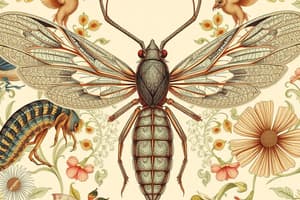Podcast
Questions and Answers
Which invertebrates are typically macrophagous organisms?
Which invertebrates are typically macrophagous organisms?
- Cephalopod molluscs
- Crustaceans
- Arthropods
- All of the above (correct)
Which feeding mechanism involves extracting food particles by filtering water?
Which feeding mechanism involves extracting food particles by filtering water?
- Particulate feeding
- Macrophagy
- Fluid or Soft Tissue Feeding
- Suspension feeding (correct)
What is another term for invertebrates that feed on particulate food material of very small size?
What is another term for invertebrates that feed on particulate food material of very small size?
- Suspension feeders
- Macrophagous animals
- Filter feeders
- Ciliary feeders (correct)
What do macrophagous feeders typically feed on?
What do macrophagous feeders typically feed on?
Which type of feeders generally suck fluid food?
Which type of feeders generally suck fluid food?
Which category of invertebrates make effective use of their cilia or setae for obtaining food?
Which category of invertebrates make effective use of their cilia or setae for obtaining food?
Flashcards are hidden until you start studying
Study Notes
Macrophagous Invertebrates
- Macrophagous organisms include larger invertebrates such as some mollusks, echinoderms, and crustaceans.
- These invertebrates typically feed on larger food particles rather than microscopic ones.
Feeding Mechanism: Filtration
- The feeding mechanism that involves extracting food particles by filtering water is known as filter feeding.
- Organisms such as bivalves and certain sponges utilize this method to capture suspended particles.
Particulate Feeders
- Invertebrates that feed on very small particulate food material are referred to as microphagous organisms.
- These organisms target algae, bacteria, and other minuscule debris.
Diet of Macrophagous Feeders
- Macrophagous feeders typically consume larger organic matter, including detritus, plant material, and other invertebrates.
- This feeding strategy contributes to the nutrient cycling in ecosystems.
Fluid Feeders
- Fluid feeders generally suck fluid food, including nectar from flowers or blood from host organisms.
- Examples include certain insects like mosquitoes and parasitic worms.
Cilia and Setae Utilization
- Ciliated or setose invertebrates, such as various polychaete worms and certain protozoans, effectively use their extensions for obtaining food.
- These structures enable efficient movement and capture of food particles from the surrounding environment.
Studying That Suits You
Use AI to generate personalized quizzes and flashcards to suit your learning preferences.




